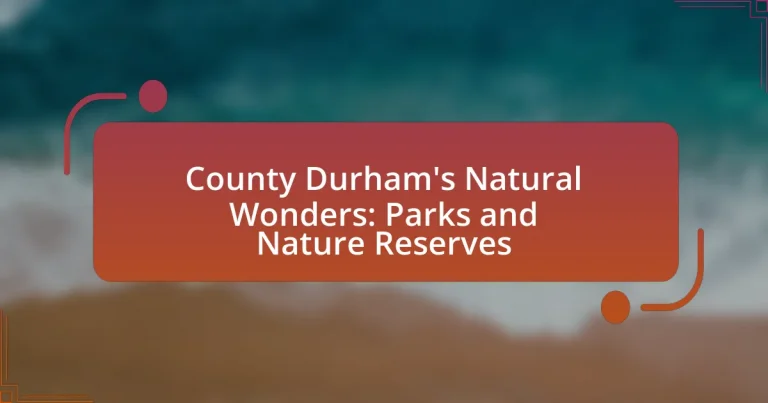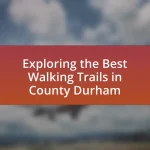County Durham’s natural wonders encompass a variety of parks and nature reserves, including the North Pennines Area of Outstanding Natural Beauty, the Durham Heritage Coast, and Teesdale. These areas are recognized for their stunning landscapes, rich biodiversity, and unique ecosystems that support various plant and animal species. The article explores the ecological significance of these natural spaces, their role in conservation, and the recreational opportunities they provide for visitors. Additionally, it highlights the importance of parks and reserves in promoting health, well-being, and sustainable tourism within the community. Key features, accessibility, and seasonal activities in these natural areas are also discussed, offering insights into how visitors can engage with and appreciate County Durham’s diverse environments.

What are the Natural Wonders of County Durham?
The natural wonders of County Durham include the stunning landscapes of the North Pennines Area of Outstanding Natural Beauty, the dramatic cliffs of the Durham Heritage Coast, and the serene beauty of Teesdale. The North Pennines features diverse wildlife and unique geological formations, recognized as a UNESCO Global Geopark. The Durham Heritage Coast offers spectacular views and rich biodiversity, while Teesdale is known for its picturesque valleys and the iconic High Force waterfall, one of England’s highest waterfalls at 21 meters. These sites collectively showcase the region’s natural beauty and ecological significance.
How do Parks and Nature Reserves contribute to County Durham’s landscape?
Parks and nature reserves significantly enhance County Durham’s landscape by preserving biodiversity and providing natural habitats. These areas serve as crucial ecosystems that support various plant and animal species, contributing to ecological balance. For instance, the North Pennines Area of Outstanding Natural Beauty, which includes several parks and reserves, is home to unique flora and fauna, including rare species like the black grouse. Additionally, these green spaces offer recreational opportunities and improve air quality, further enriching the region’s environmental health. The presence of parks and nature reserves also promotes sustainable tourism, drawing visitors to experience County Durham’s natural beauty while fostering conservation efforts.
What types of ecosystems can be found in these parks and reserves?
County Durham’s parks and reserves feature diverse ecosystems, including woodlands, wetlands, grasslands, and coastal habitats. These ecosystems support a variety of flora and fauna, contributing to the region’s biodiversity. For instance, the North Pennines Area of Outstanding Natural Beauty contains upland moorland, while the Teesdale area is known for its rich hay meadows and riverine ecosystems. The presence of these distinct ecosystems is crucial for conservation efforts and ecological studies in the region.
How do these natural areas support biodiversity in County Durham?
Natural areas in County Durham support biodiversity by providing diverse habitats that sustain various plant and animal species. These habitats, such as woodlands, wetlands, and grasslands, create ecological niches that allow for species richness and genetic diversity. For instance, the North Pennines Area of Outstanding Natural Beauty is home to unique flora and fauna, including rare species like the black grouse and various orchids, which thrive in its varied landscapes. Additionally, the preservation of these natural areas helps maintain ecosystem services, such as pollination and water purification, which are vital for sustaining both wildlife and human populations.
Why are Parks and Nature Reserves important for conservation?
Parks and nature reserves are crucial for conservation because they protect biodiversity and provide habitats for various species. These protected areas serve as sanctuaries for flora and fauna, helping to preserve ecosystems that are vital for ecological balance. For instance, according to the International Union for Conservation of Nature, protected areas cover about 15% of the Earth’s land surface and are essential for safeguarding endangered species and maintaining genetic diversity. Furthermore, parks and nature reserves facilitate research and education, promoting awareness of conservation issues and fostering a connection between people and nature.
What role do these areas play in protecting endangered species?
Protected areas such as parks and nature reserves in County Durham play a crucial role in safeguarding endangered species by providing essential habitats that support their survival and reproduction. These designated spaces help maintain biodiversity by preserving ecosystems that are critical for the life cycles of various species. For instance, the North Pennines Area of Outstanding Natural Beauty, which encompasses parts of County Durham, is home to several endangered species, including the black grouse and the red squirrel, both of which rely on specific habitats that these protected areas offer. By limiting human activities such as urban development and industrial exploitation, these areas reduce threats to wildlife, thereby enhancing the chances of recovery for endangered species.
How do they contribute to climate change mitigation?
County Durham’s parks and nature reserves contribute to climate change mitigation by sequestering carbon dioxide and enhancing biodiversity. These natural areas absorb CO2 through photosynthesis, with trees and vegetation acting as carbon sinks. For instance, a mature tree can absorb approximately 48 pounds of CO2 annually, significantly reducing greenhouse gas levels. Additionally, these ecosystems support diverse flora and fauna, which can improve resilience to climate impacts and promote ecological balance. By preserving these natural habitats, County Durham actively aids in reducing the overall carbon footprint and fostering a healthier environment.
What recreational opportunities do County Durham’s Parks and Nature Reserves offer?
County Durham’s Parks and Nature Reserves offer a variety of recreational opportunities, including walking, cycling, birdwatching, and picnicking. These activities are facilitated by well-maintained trails, designated cycling paths, and scenic viewpoints that enhance the outdoor experience. For instance, popular sites like Hamsterley Forest provide extensive walking and cycling routes, while the RSPB Saltholme reserve is known for its birdwatching facilities, attracting numerous species and enthusiasts.
What activities can visitors engage in while exploring these natural wonders?
Visitors can engage in hiking, birdwatching, and photography while exploring County Durham’s natural wonders, including its parks and nature reserves. Hiking trails are available in areas like Hamsterley Forest, offering diverse landscapes and varying difficulty levels. Birdwatching opportunities abound in locations such as the Teesdale area, where species like the peregrine falcon can be observed. Additionally, photography enthusiasts can capture stunning vistas and wildlife, particularly in the North Pennines Area of Outstanding Natural Beauty, which is recognized for its scenic beauty and biodiversity.
How do these parks promote health and well-being for the community?
Parks in County Durham promote health and well-being for the community by providing accessible green spaces that encourage physical activity and mental relaxation. These parks offer facilities for walking, jogging, and recreational sports, which contribute to improved physical fitness and reduced obesity rates. Research indicates that spending time in nature can lower stress levels and enhance mood, with studies showing that individuals who engage in outdoor activities report higher levels of happiness and lower levels of anxiety. Additionally, parks serve as social hubs, fostering community interaction and support networks, which are essential for mental health. The presence of diverse flora and fauna in these parks also enhances biodiversity, contributing to ecological health, which indirectly supports community well-being.

Which are the most notable Parks and Nature Reserves in County Durham?
The most notable parks and nature reserves in County Durham include Hamsterley Forest, which spans over 2,000 acres and offers diverse wildlife and walking trails; the North Pennines Area of Outstanding Natural Beauty, recognized for its stunning landscapes and rich biodiversity; and the Durham Wildlife Trust reserves, such as Low Barns Nature Reserve, known for its wetlands and birdwatching opportunities. These locations are significant for their ecological importance and recreational value, attracting visitors for both leisure and conservation activities.
What are the key features of each major park or reserve?
The key features of each major park or reserve in County Durham include diverse ecosystems, recreational opportunities, and historical significance. For example, Hamsterley Forest is known for its extensive woodlands, walking and cycling trails, and rich wildlife, including deer and various bird species. The North Pennines Area of Outstanding Natural Beauty features stunning landscapes, unique geological formations, and habitats for rare species, making it ideal for hiking and nature observation. Teesdale, with its picturesque valleys and rivers, offers opportunities for fishing and birdwatching, while the Durham Wildlife Trust reserves focus on conservation and education, showcasing local flora and fauna. Each park and reserve contributes to the region’s biodiversity and provides spaces for outdoor activities and environmental awareness.
How do the landscapes differ among these parks?
The landscapes among the parks in County Durham differ significantly in topography, vegetation, and geological features. For instance, Hamsterley Forest is characterized by dense woodlands and hilly terrain, providing a rich habitat for diverse wildlife. In contrast, the Durham Dales, including areas like Teesdale, showcase dramatic valleys and limestone formations, which create a unique geological landscape. Additionally, the coastal parks, such as the North Pennines Area of Outstanding Natural Beauty, feature rugged cliffs and coastal heathland, offering a stark contrast to the inland forested areas. These variations in landscape are influenced by factors such as elevation, soil type, and climate, which contribute to the distinct ecological characteristics of each park.
What unique flora and fauna can be found in each location?
County Durham’s parks and nature reserves host unique flora and fauna, including the rare purple moor grass and the endangered black grouse. In Hamsterley Forest, diverse species such as the red squirrel and various fungi thrive, while the North Pennines Area of Outstanding Natural Beauty features unique plants like the alpine meadow and animals such as the curlew. The Teesdale area is known for its rich biodiversity, including the rare lady’s slipper orchid and the otter. Each location supports distinct ecosystems that contribute to County Durham’s natural heritage.
How accessible are these parks and reserves for visitors?
The parks and reserves in County Durham are generally accessible for visitors, with many featuring well-maintained paths and facilities. For instance, popular sites like Hamsterley Forest and Teesdale offer designated walking trails, parking areas, and visitor centers that enhance accessibility. Additionally, public transport options are available to reach several parks, making them convenient for a wider audience.
What transportation options are available to reach these natural sites?
Public transportation options to reach County Durham’s natural sites include buses and trains, which connect major towns and cities to parks and nature reserves. For instance, the bus services operated by Arriva and Go North East provide routes to popular destinations like Hamsterley Forest and Teesdale. Additionally, the train services from Durham to Bishop Auckland offer access to the scenic areas surrounding the Weardale Valley. These transportation methods are reliable and frequently used by visitors to explore the natural wonders of County Durham.
Are there facilities for families and individuals with disabilities?
Yes, County Durham’s parks and nature reserves provide facilities for families and individuals with disabilities. Many locations feature accessible paths, designated parking spaces, and adapted restrooms to ensure inclusivity. For instance, popular sites like Hardwick Park and Hamsterley Forest have been designed with accessibility in mind, allowing individuals with mobility challenges to enjoy the natural environment.
How can visitors make the most of their experience in County Durham’s Parks and Nature Reserves?
Visitors can make the most of their experience in County Durham’s Parks and Nature Reserves by engaging in various outdoor activities such as hiking, birdwatching, and picnicking. These parks, including popular sites like Hamsterley Forest and the North Pennines Area of Outstanding Natural Beauty, offer well-marked trails and diverse wildlife, enhancing the visitor experience. Additionally, participating in guided tours or educational programs can provide deeper insights into the local ecology and history, making the visit more enriching. The availability of facilities such as visitor centers and picnic areas further supports a comfortable and enjoyable outing.
What tips should visitors keep in mind when exploring these areas?
Visitors exploring County Durham’s parks and nature reserves should prioritize safety, respect for nature, and local regulations. Safety includes wearing appropriate footwear for uneven terrain and being aware of weather conditions, as these areas can have sudden changes in weather. Respecting nature involves not disturbing wildlife and sticking to marked paths to preserve the ecosystem. Additionally, visitors should familiarize themselves with local regulations, such as restrictions on fires or camping, to ensure a safe and enjoyable experience. These practices help maintain the natural beauty and integrity of County Durham’s landscapes.
How can visitors practice responsible tourism in natural spaces?
Visitors can practice responsible tourism in natural spaces by adhering to the principles of Leave No Trace, which emphasizes minimizing environmental impact. This includes staying on designated trails to prevent soil erosion and protecting native flora and fauna. Additionally, visitors should pack out all trash, including biodegradable waste, to maintain the cleanliness of the area. According to the Leave No Trace Center for Outdoor Ethics, following these guidelines helps preserve the integrity of natural habitats and ensures that future generations can enjoy these spaces.
What resources are available for planning a visit to these parks?
Resources available for planning a visit to County Durham’s parks include official park websites, visitor centers, and local tourism boards. Official park websites provide detailed information on park hours, amenities, and activities, while visitor centers offer maps, brochures, and staff assistance for personalized guidance. Local tourism boards, such as Visit County Durham, compile comprehensive resources including itineraries, accommodation options, and event calendars, ensuring visitors have access to all necessary information for an enjoyable experience.
What are the best times of year to visit County Durham’s Parks and Nature Reserves?
The best times of year to visit County Durham’s Parks and Nature Reserves are spring and autumn. During spring, typically from March to May, visitors can enjoy blooming flowers and mild weather, making it ideal for outdoor activities. Autumn, from September to November, offers vibrant foliage and comfortable temperatures, enhancing the natural beauty of the reserves. These seasons provide optimal conditions for wildlife observation and hiking, as many species are active and the landscapes are particularly picturesque.
How does seasonal change affect the experience in these natural areas?
Seasonal change significantly affects the experience in County Durham’s natural areas by altering the landscape, wildlife behavior, and recreational opportunities. In spring, blooming flowers and active wildlife enhance the beauty and vibrancy of parks and reserves, attracting visitors for activities like birdwatching and hiking. Summer offers lush greenery and longer days, ideal for outdoor events and family outings. Autumn transforms the scenery with colorful foliage, providing a picturesque backdrop for photography and nature walks. Winter, while often quieter, presents unique opportunities for activities such as snowshoeing and winter wildlife observation. These seasonal variations not only enrich the aesthetic appeal but also influence visitor engagement and the types of experiences available throughout the year.
What events or activities are held throughout the year in these parks?
County Durham’s parks and nature reserves host a variety of events and activities throughout the year, including guided nature walks, wildlife observation days, educational workshops, and seasonal festivals. For example, parks often organize birdwatching events during migration seasons, while educational workshops may focus on local flora and fauna, promoting environmental awareness. Additionally, seasonal festivals celebrate local culture and biodiversity, attracting visitors and fostering community engagement. These activities are designed to enhance public appreciation of the natural environment and encourage outdoor recreation.




